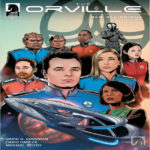Writer: David A. Goodman
Artist: David Cabeza
Colorist: Michael Atiyeh
Publisher: Dark Horse Comics
When talking with a friend about The Orville, Seth MacFarlane’s science fiction dramedy, she put it best when she said: “That show has no right being as good as it is.”
I can understand what she meant: while I enjoyed the early seasons of Family Guy, the show’s luster faded after a while, and for the most part, MacFarlane’s brand of humor wasn’t really my cup of tea.
But something MacFarlane and I share is a deep and abiding love of Star Trek, so when I heard he was developing a science fiction comedy series called The Orville about an idealistic but hapless captain and his ex-wife first officer exploring space with a motley crew, my reaction was … mixed, to put it mildly. What a difference two years makes. The Orville is one of my favorite science fiction series currently on television, and when I heard that Dark Horse Comics was going to publish an Orville series, I was all in. How did it work out? Well let’s take a look at The Orville #1 and find out.
The Orville #1 opens between the ending of season one and the beginning of season two. Captain Ed Mercer and his helmsman Gordon Malloy are on their way to a conference when they intercept a distress signal from a century-old buoy that may provide answers to the loss of a legendary Union ship. Back on the Orville, Commander Kelly Grayson is faced with a predicament when Lieutenant Commander Bortus asks to enroll his son Topa in school … when he’s only a few months old. Needless to say, things aren’t quite what they seem, and by the issue’s end, we’re left with a great many questions but only a few answers.
I think it’s a safe bet to say that I was in the tank for The Orville #1, but on learning it was being written by David A. Goodman, I knew I was going to be in for some fun. Goodman has written several pieces of Star Trek fiction (one of which, The Autobiography of Captain Kirk I reviewed previously), and he is co-producer of The Orville with MacFarlane. He has the character’s mannerisms and dialogue down pat, which makes the comic feel very much of a piece with the television show.
David Cabeza’s art is faithful to the series itself, perhaps to the point where it’s something of a detriment. It’s very good, but it feels like the comic is made to resemble the series as much as possible, when with comics, you can add some personal artistic flourishes to the piece and make it your own. I wasn’t expecting Star Trek: The Animated Series levels of departure, but it would’ve been fun to see Cabeza cut loose and create some interesting alien designs, which, to be fair, we do get a bit of by the end of the issue. Perhaps we’re grounding things in an approximation of the show’s visual style before we move into the truly fantastic. Michael Atiyah’s colors definitely make the art pop, and they help emphasize the optimistic fun of the comic’s source material.
Simply put, The Orville #1 is a fun space opera comic. Knowledge of the show is a plus, but the characters are archetypal enough that it’s likely you won’t be too lost if you’re a newcomer (that said, if you haven’t watched The Orville yet, you really really should). If you like the series as much as I do, it’s more of what you love. Recommended.




